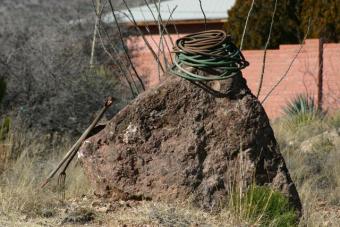
There are many fall tasks in the garden that will make your plants healthier and more beautiful next spring. This is a beautiful time of year to work outdoors, and you'll love the results!
Prolong Bloom
Everyone is sorry to see flowers fade away in the fall. You can keep flowers in your garden a little longer by protecting plants at night. Cover the plants with cloth or plastic sheets, newspaper tents, boxes, or bushel baskets to protect them from light frost. If a sudden cold snap catches you unprepared, you may be able to protect lightly frosted plants by hosing them with water before sunrise.
Fertilize
Stop fertilizing your garden in midsummer or switch to a "winterizer" fertilizer. Nitrogen-heavy fertilizers stimulate new, soft growth that won't have a chance to mature before freezing weather. Winterizer fertilizer, which is high in potassium and low in nitrogen, encourages strong root growth and helps plants prepare for winter.
Prune
Late winter is the best time for heavy pruning, but trees and shrubs benefit from having any diseased material pruned out in the fall. Insect infestations, like Webworms, can be pruned out at any time.
Once leaves have dropped, dead, damaged, and diseased material is easier to see. Prune six to twelve inches beyond the diseased area. Dip the pruners in a ten percent bleach solution between cuts to prevent spreading disease any further. You can make the solution by adding one part bleach to nine parts water.
Bulbs
You will need to lift and store the bulbs or tubers of tender plants like gladioli, dahlias, and tuberous begonias if you live in an area with cold winters. If you want to enjoy the bright colors of daffodils, tulips, and other spring-flowering bulbs next year, now is the time to plant them.
Mark Plants
Mark the location of perennials that are slow to start in the spring and of young plants that have self-seeded over the summer. This will keep you from digging them up accidentally next spring!
Drawing a plan of the garden, with locations of all plant locations marked, will make it easier to plan for next year's gardening.
Cut Back Perennials
You will remove any diseased foliage when you clean up your garden, but which perennials you cut back is a matter of choice. Some gardeners admire the look of perennials dusted with snow or frost and leave them intact for their aesthetic appeal. Don't cut back any perennial that you find beautiful!
Cut back plants that are ugly after frost. Some plants, like veronicas or geraniums, turn to mush in the cold. They are unsightly in the garden, and they also encourage disease.
Don't cut back perennials that are marginally hardy in your area. The dead foliage will help protect the plant crowns during the winter.
Leave a large part of the stem in place on any perennials that are slow to start growing in the spring, like plumbago or blue wild indigo. The stems will mark their location next spring, so you don't dig them up by accident.
Many perennials should be divided or transplanted in the fall.

Plant Trees and Shrubs
Fall is an ideal time to plant trees and shrubs. If you are choosing them for their fall color, this is the only time to evaluate the color of each individual plant.
Mow
Most turfgrass species continue to grow slowly until late fall. Applying herbicide in early fall will help control weeds. Mow with the mower blades set low in the fall. Grass should be no taller than two inches going into winter. In an area where snow mold or powdery mildew is a problem, grass should be cut to one and a half inches.
Indoor Plants
Tropical houseplants often benefit from a summer spent outdoors, but they should be brought indoors well before the first frost. Inspect them for insects, cut them back if necessary, and repot any that have outgrown their pots. Some leaves may brown or drop as the plants adjust to lower indoor light and humidity levels.
Cuttings
Fall is the best time to increase your stock of plants by taking cuttings and rooting them. Tender perennials like geraniums (perlargoniums) and impatiens can easily be grown indoors from cuttings taken in the fall, and they will be ready to set out next spring. Hardwood cuttings taken from shrubs and hardy perennials are started from cuttings taken in fall as well.
Sowing Seed
In areas with warm winter areas, it's possible to plant seeds in fall for early spring bloom. Winter sweet peas are likely to be in blossom for the New Year.
Many perennial and biennial seeds need a cold period before they will sprout. These seeds can also be sown directly in the garden in the fall.
Dormancy
In cold-weather areas, frost and freezes push plants into full dormancy each fall. In warmer areas, many plants also go dormant in response to shortened daylength. Gardeners can help this process by changing or stopping fertilization fertilization in midsummer and slowly withholding water in the fall.







